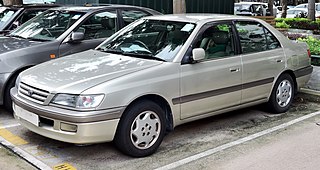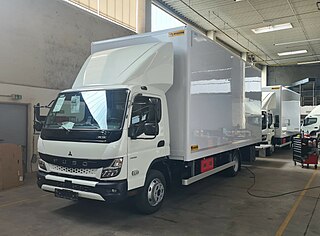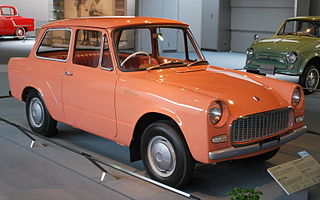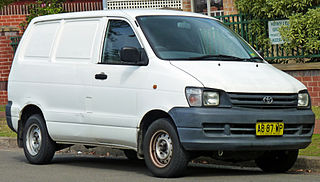
The Mazda Bongo, also known as Mazda E-Series and the Ford Econovan, is a cabover van and pickup truck manufactured by the Japanese automobile manufacturer Mazda since 1966. The Bongo name was also used for the Bongo Friendee, which is not a cabover design.

The Toyota Corona is an automobile manufactured by the Japanese automaker Toyota across eleven generations between 1957 and 2001. On launch, the Corona was Toyota's second-highest product in their range, just below the Crown. The Corona was marketed in the JDM at Toyota's Toyopet Store dealership channels, and the Corona was one of Toyota's first models exported to other global markets, followed by the smaller Toyota Corolla.

The Isuzu MU is a mid-size SUV which was produced by Japan-based manufacturer Isuzu from 1989 to 2004.

The Toyota Carina is an automobile which was manufactured by Toyota from December 1970 to December 2001. It was introduced as a sedan counterpart of the Celica, with which it originally shared a platform. Later, it was realigned to the Corona platform, but retained its performance image, with distinctive bodywork and interior — aimed at the youth market and remaining exclusive to Japanese Toyota dealerships Toyota Store. It was replaced in Japan by the Toyota Allion in 2001 and succeeded in Europe by the Toyota Avensis.

The Datsun Truck is a compact pickup truck made by Nissan in Japan from 1955 through 1997. It was originally sold under the Datsun brand, but this was switched to Nissan in 1983. It was replaced in 1997 by the Frontier and Navara. In Japan, it was sold only in Nissan Bluebird Store locations.

The Toyota HiAce is a light commercial vehicle produced by the Japanese automobile manufacturer Toyota. First launched in October 1967, the HiAce has since been available in a wide range of body configurations, including a minivan/MPV, minibus, panel van, crew van, pickup truck, taxi and an ambulance. In Japan, the HiAce is exclusive to Toyopet Store locations.

The Volkswagen Taro 1 tonne pickup truck was introduced in January 1989 by Volkswagen Commercial Vehicles to complement the half tonne Caddy pickup / panel van ranges, and the 1 tonne Transporter van and chassis cab ranges. The name "tarō" is a suffix used in Japanese to denote the oldest brother or son, or the first-born son of a family.

The Toyota Dyna is a light to medium-duty cab over truck for commercial use. In the Japanese market, the Dyna is sold alongside its twin called the Toyoace. The Toyoace was a renaming of the Toyopet SKB Truck as a result of a 1956 public competition with 200,000 entries. "Dyna" is short for dynamic.

The Mitsubishi Fuso Canter is a line of light-duty commercial vehicles manufactured by Mitsubishi Fuso Truck and Bus Corporation, part of Daimler Truck, subsidiary of Mercedes-Benz Group. The Canter is manufactured since 1963, now in its eighth generation. The Canter is named after the English word describing the gait of a horse, emphasising the 'thoroughbred' nature of Mitsubishi trucks.

The 70 Series is a family of Toyota Land Cruiser models produced since 1984. It replaced the 25-year-old 40 Series as the off-road model of the Land Cruiser lineup, while the contemporary 60 Series developed into more comfortable luxury SUVs starting with the 80 Series. Despite major changes in styling and numerous technological updates, the 70 Series was designed to retain the off-road capabilities and durability associated with the 40 Series.

The Toyota Publica is a small car manufactured by the Japanese company Toyota from 1961 until 1978. Conceived as a family car to fulfill the requirements of the Japanese Government's "national car concept", it was the smallest Toyota car during that period and was superseded in that role by the Toyota Starlet, which itself started out as a version of the Publica. It was available as a 2-door vehicle only, but in a selection of body styles, ranging from the base sedan through a station wagon, convertible, coupé and even a coupe utility (pickup), which outlived the other models by a decade, and spawned other models, such as the Toyota Sports 800 and the Toyota MiniAce.

The Hino Dutro is a light commercial truck manufactured by Hino Motors. It is a rebadged version of the Toyota Dyna. Like the Dyna and its twin ToyoAce, the Dutro is built on the U300 platform for the standard cab, or U400 platform for the wide cab and offered in many different chassis type suitable for different purposes. The Dutro took over from the earlier Ranger 2, a badge-engineered version of the Daihatsu Delta series. Outside of Japan, it is also known as the '300 series'. In North America, it has been marketed as the 'M Series' since the 2021 model year.
The Toyota F series engine was a series of OHV inline-6-cylinder engines produced by Toyota between November 1949 and 1992. They are known for their high amount of torque at low engine speeds, massive cast-iron blocks and heads and also their high reliability. The F engine had one of the longest production runs of any Toyota engine. The F engines all incorporate overhead valves actuated by pushrods from a gear driven camshaft in the lower portion of the engine.

The Toyota LiteAce and TownAce are a line of light commercial and derivative passenger vans produced by the Japanese car manufacturer Toyota. These vehicles originally utilized the cab-over-engine configuration, although since 1996 a semi-cab-over arrangement has featured instead. The LiteAce launched in 1970 as light-duty truck, with commercial and van/wagon body variants added in 1971. In 1976, Toyota released the larger TownAce van/wagon that derived from the LiteAce; a TownAce truck arrived later in 1978. Between 1982 and 1992, the series accommodated the MasterAce Surf—an upscale TownAce passenger wagon.

The Piaggio Porter is a cab over microvan and pick-up produced and sold by the Italian company Piaggio since 1992 under the Piaggio Commercial Vehicle brand.

The Toyota ToyoAce is a light to medium cab over truck built by Toyota since September 1954. Until a renaming contest in 1956, the truck was sold as the "Toyopet Light Truck SKB". Since 1985 the ToyoAce and Dyna truck lines have been merged, with the Dynas generally being intended for heavier duty work. In Japan, it was exclusive to Japanese Toyota dealerships called Toyopet Store.
Skyactiv is a brand name for a series of automobile technologies developed by Mazda that increase fuel efficiency and engine output. The initial announcement of the Skyactiv technologies included new engines, transmissions, body, and chassis, which appeared in Mazda products from 2011 onwards.

The Toyota GD engine series is a diesel engine produced by Toyota which appeared in 2015. It replaced the Toyota KD engine series as a diesel engine series mainly oriented to body-on-frame vehicles. The GD engine featured Economy with Superior Thermal Efficient Combustion (ESTEC) technology. Toyota claims they have a maximum thermal efficiency of 44 percent, "top class" at the time of introduction.
Alfa Romeo A15 / A19 / A38 / F20 are a discontinued line of utility trucks, or lorries, produced by Alfa Romeo from 1967-1974.
The Toyota FA and BA were heavy duty trucks introduced in February 1954. They were facelifted versions of the earlier BX/FX trucks, retaining those trucks Type B and Type F six-cylinder petrol engines. The first letter in the model name indicates the engine family fitted; in 1957 the Type D diesel engine was introduced in a model known as the DA. The second letter indicated the size of the truck, with shorter medium duty versions being coded BC/FC/DC. A second letter "B" was used on bus versions of this chassis. A second generation FA/DA was introduced in 1964 and was built in Japan until 1980, when Hino replaced Toyota's heavier truck lines entirely. The DA, however, was also built in numerous other countries and manufacture continued into the first decade of the 21st century.



















